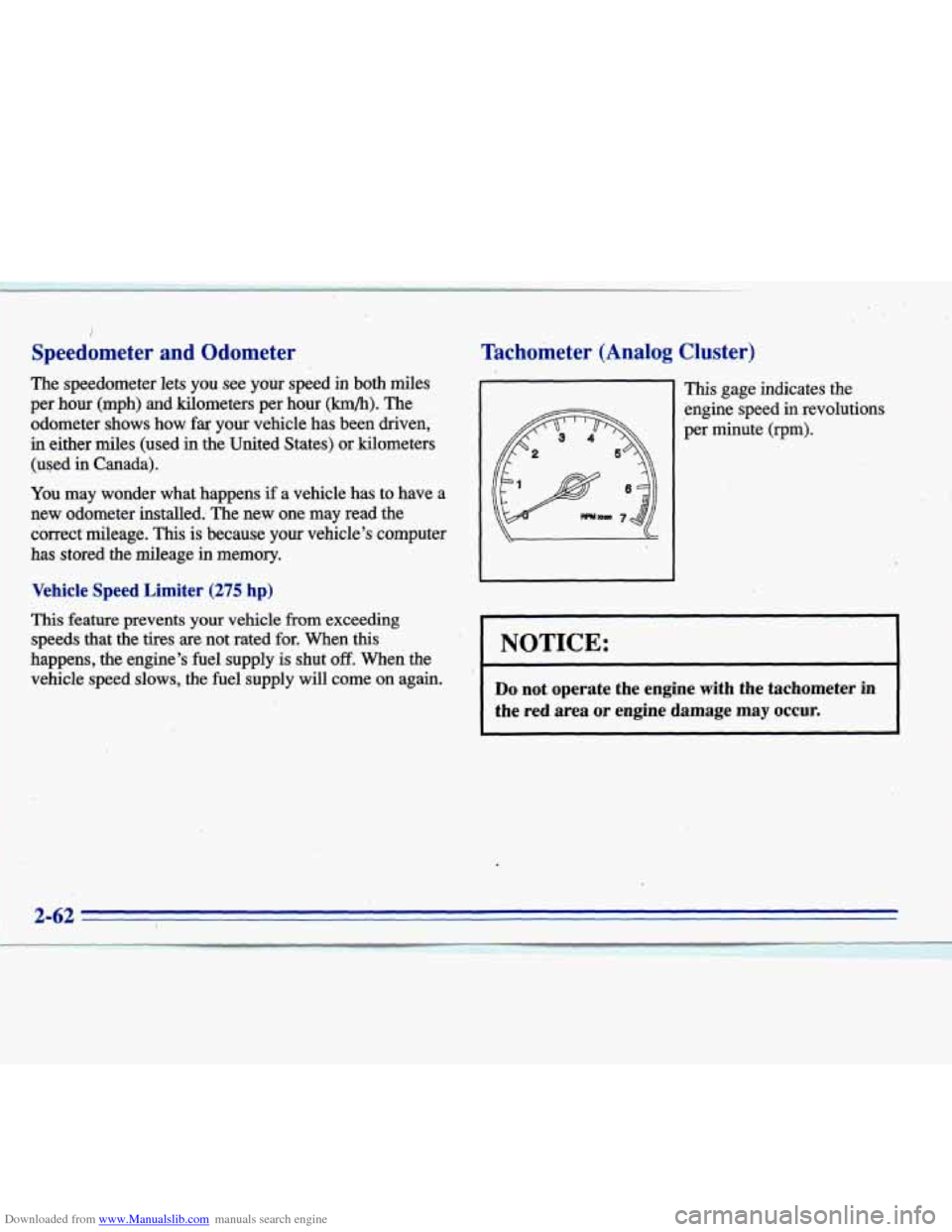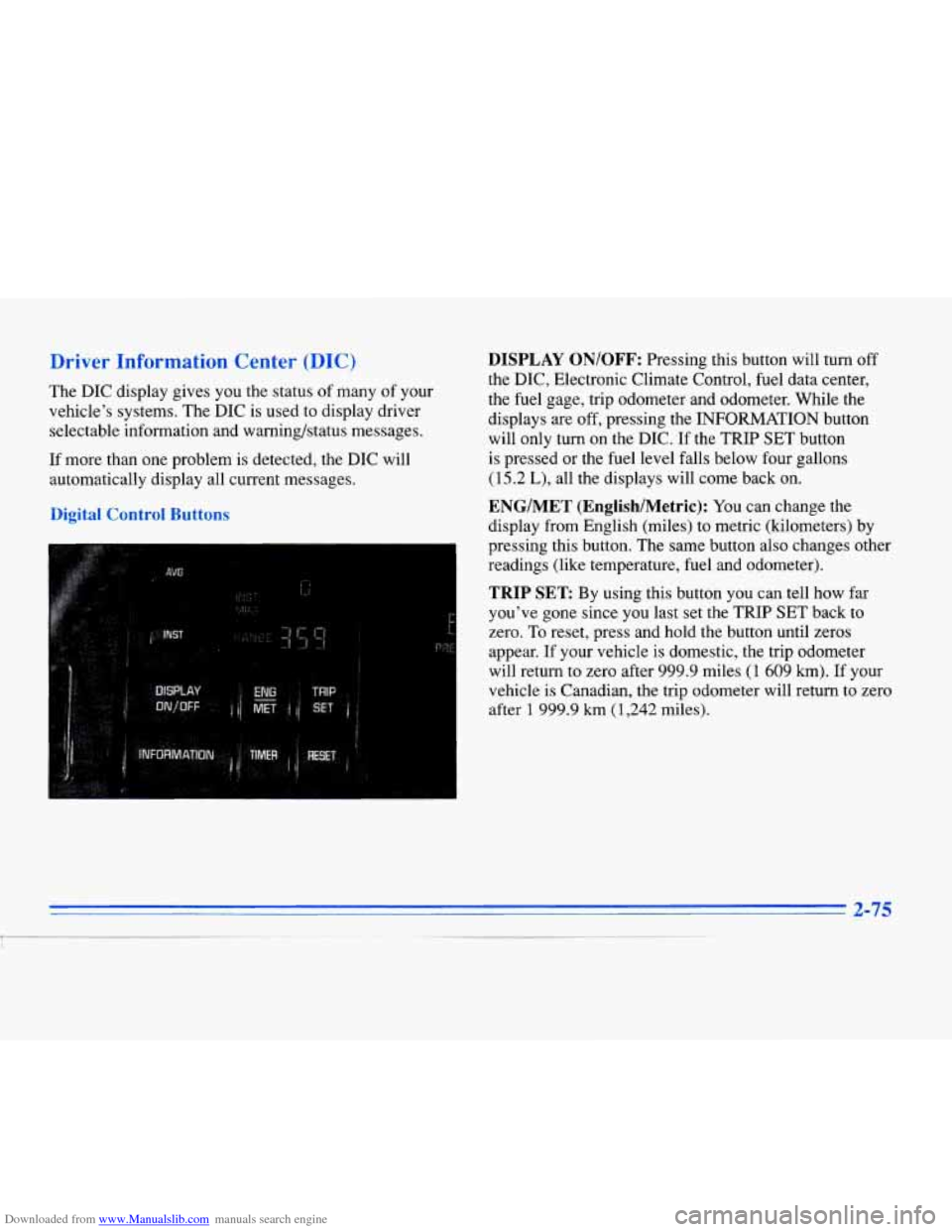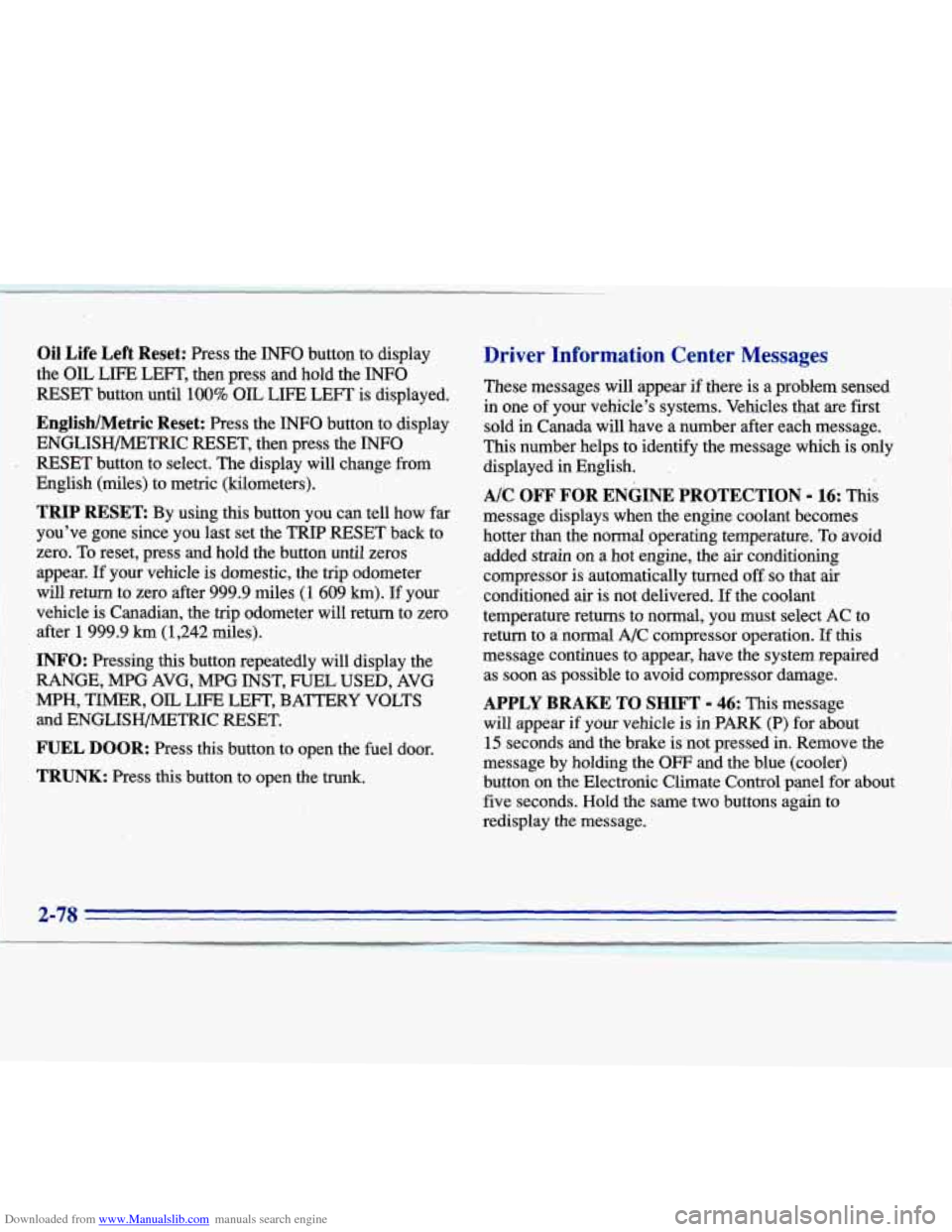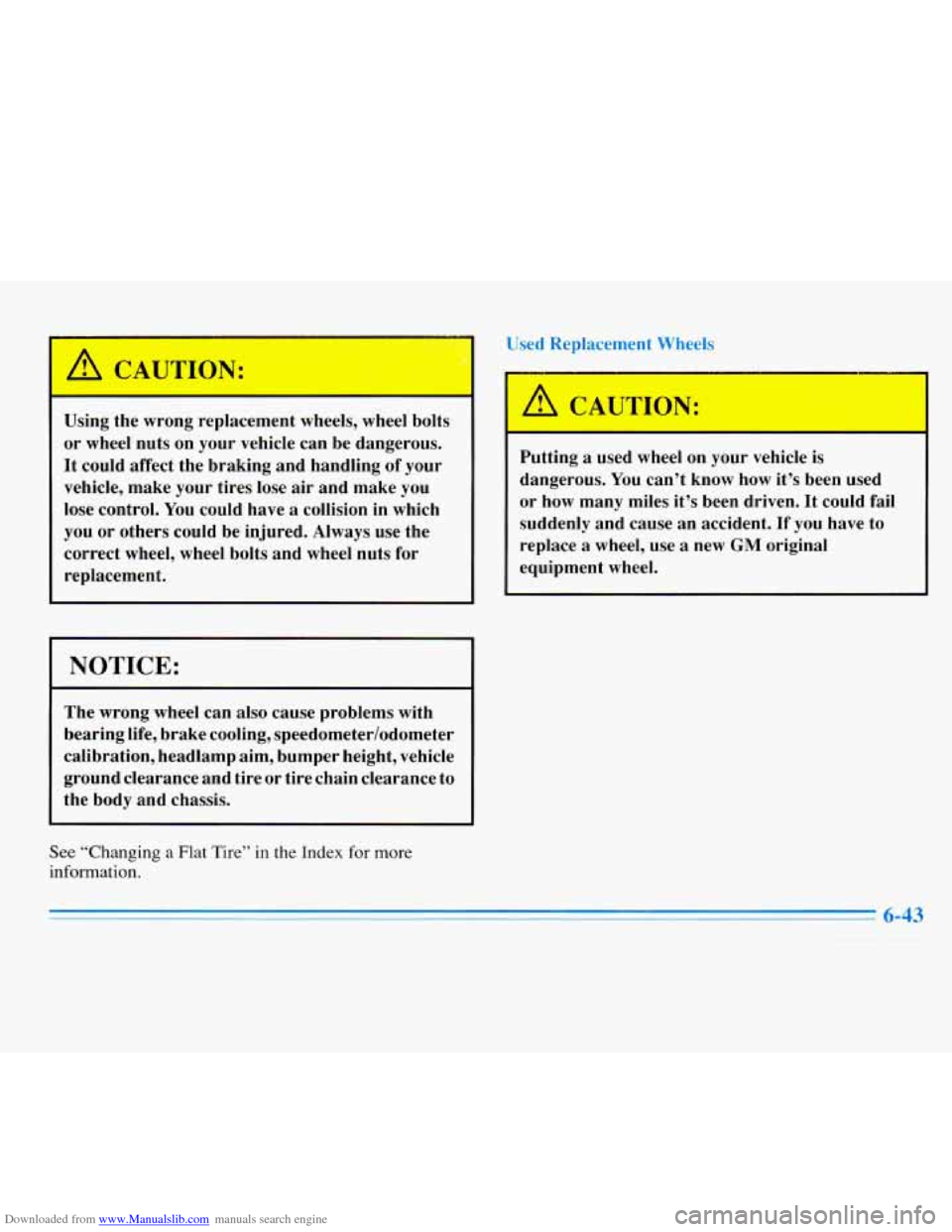1996 CADILLAC ELDORADO odometer
[x] Cancel search: odometerPage 123 of 354

Downloaded from www.Manualslib.com manuals search engine i
Speedometer and Odometer
.- The speedometer lets you see your speed in both miles
per hour (mph) and kilometers per hour
(km/h). The
odometer shows
how far; your vehicle has been driven,
in either miles (used
in the United States) or kilometers
@Sed
in Canada).
You may wonder what happens if a vehicle has to have a
new odometer installed. The new one may read the
correct mileage.
This is because your vehicle's computer
. has stored the mileage in memory.
Vehicle Speed Limiter (275 hp)
This feature prevents your vehicle from exceeding
speeds that the tires are not rated for. When this
whicle speed slows,
the fuel supply will come on again.
' happens, the engine's fuel supply is shut off. When the
Tachometer (Analog Cluster)
This gage indicates the
engine speed
in revolutions
per minute
(rpm).
I NOTICE:
~~ ~~
Do not operate the engine with the tachometer in
the
red area or engine damage may occur.
Page 136 of 354

Downloaded from www.Manualslib.com manuals search engine The DIC display gives you the status of many of your
vehicle’s systems. The DIC is used to display driver
selectable information and warning/status messages.
If more than one problem is detected, the DIC will
automatically display all current messages.
It i,”, i
I TRIP
i
pgi
i
DISPLAY ON/OFF: Pressing this button will turn off
the DIC, Electronic Climate Control, fuel data center,
the fuel gage, trip odometer and odometer. While the
displays
are off, pressing the INFORMATION button
will only turn
on the DIC. If the TRIP SET button
is pressed or the fuel level falls below four gallons
(15.2 L), all the displays will come back on.
ENGlMET (English/Metric): You can change the
display from English (miles) to metric (kilometers) by
pressing this button. The same button also changes other
readings (like temperature, fuel and odometer).
TRIP SET: By using this button you can tell how far
you’ve gone since you last set the TRIP SET back to
zero. To reset, press and hold the button until zeros
appear.
If your vehicle is domestic, the trip odometer
will return to zero after 999.9 miles
(1 609 km). If your
vehicle is Canadian, the trip odometer will return to zero
after
1 999.9 km (1,242 miles).
75
Page 139 of 354

Downloaded from www.Manualslib.com manuals search engine Oil Life Left Reset: Press the INFO button to display
the
OIL LIFE LEFT, then press and hold the INFO
RESET button until 100% OIL LIFE LEFT is displayed.
English/Metric Reset: Press the INFO button to display
ENGLISH/METRIC RESET, then press the
INFO
RESET button to select. The display will change from
English (miles) to metric (kilometers).
TRIP RESET By using this button you can tell how far
you've gone since you last set the
TRIP RESET back to
zero.
To reset, press, and hold the button until zeros
appear.
If your vehicle is domestic, the trip odometer
will return
to zero after 999.9 miles (1 609 km). If your
vehicle
is Canadian, the trip odometer will return to zero
after
1 999.9 km (1,242.miles).
INFO: Pressing this button repeatedly will display the
RANGE, MPG AVG, MPG
INST, FUEL USED, AVG
and
ENGLISH/METRIC RESET.
" MPH, TIMER, OIL LIFE LEFT, BATTERY VOLTS
FUEL DOOR: Press this button to open the fuel door.
TRUNK: Press this button to open the trunk.
Driver Information Center Messages
These messages will appear if there is a problem sensed
in one of your vehicle's systems. Vehicles that are first ,,
sold in Canada will'have a number after each message.
This number helps to identify ,the message which is only
displayed in English.
.
Ak OFF FOR ENGINE PROTECTION - 16: This
message displays when the engine coolant becomes
hotter than the normal operating temperature. To avoid
added strain on a hot engine, the air conditioning
compressor is automatically turned
oft so that air
conditioned air is not delivered.
If the coolant
temperature returns to normal, you must seIect AC to
return to a' normal A/C compressor operation.
If this
message continues to appear, have the system repaired
as soon as possible to avoid compressor damage.
APPLY BRAKE TO SHIFT - 46: This message
will appear if your vehicle is
in PARK (P) for about
15 seconds and the brake is not pressed in. Remove the
message by holding the
OFF and the blue (cooler)
button on
the Electronic Climate Control panel for about
five seconds. Hold the same two buttons again to
redisplay the message.
Page 302 of 354

Downloaded from www.Manualslib.com manuals search engine -
Using the wrong replacement wheels, wheel bolts
or wheel nuts on your vehicle can be dangerous.
It could affect the braking and handling of your
vehicle, make your tires lose air and make you
lose control.
You could have a collision in which
you or others could be injured. Always use the
correct wheel, wheel bolts and wheel nuts for
replacement.
NOTICE:
The wrong wheel can also cause problems with
bearing life, brake cooling, speedometer/odometer
calibration, headlamp aim, bumper height, vehicle
ground clearance and tire or tire chain clearance to
the body and chassis.
See “Changing a Flat Tire” in the Index for more
information.
Used Replacement Wheels
-
CAUTION:
Putting a used wheel on your vehicle is
dangerous. You can’t know how it’s been used
or how many miles it’s been driven. It could fail
suddenly and cause an accident.
If you have to
replace a wheel, use
a new GM original
equipment wheel.
6-43
Page 348 of 354

Downloaded from www.Manualslib.com manuals search engine I ! ..
I t Net. Convenience .............................. 2-52
Neutral (N). Automatic Transaxle
.................. 2-20
New Vehicle Break-In
........................... 2-14
Night Vision
.................................... 4- 16
odometer
.................................... 2-62
Odometer. Trip
............................ 2.75. 2.78
Off-RoadRecovery
............................. 4-12
Oil. Engine ...................................... 6-9
Oil Life Indicator ............................... 2-85
Oil Pressure Light .............................. 2-72
Operation
...................................... 2-7
Overdrive
(@), Automatic Transaxle ................ 2-21
Overheating Engine
............................. 5-15
OwnerPublications
............................. 7-12
Overheated Engine Protection Operating Mode
....... 5-15
Paint Spotting. Chemical
........................ 6-51
Park
(P)
Automatic Transaxle .......................... 2- 19
ShiftingInto
................................. 2-24
Shifting Out of
............................... 2-27
AtNight
..................................... 2-11
Brake
...................................... 2-22
Brake Indicator Light
.......................... 2-66
Lots
....................................... 2-11
Over Things That
Burn ........................ 2-27
WithaTrailer
................................ 4-37
Parking Pass Key Not Programmed Message
................ 2-81
Passing
.. .................................... 4-13
Passenger Temperature Control
...................... 3.8
PASS-Key
11 .................................. 2-13
PCM Fault Message
............................. 2-81
Power
Antenna Mast Care
.... ! .................... .. .. 3-36
Door Locks
................................... 2-4
Option Fuses
................................ 6-54
Remote Control Mirror
......................... 2-49
Retained Accessory
........................... 2-15
Seatback Recliner
.............................. 1-5
Steering
.................................... 4-10
Steering Fluid ................................ 6-23
Windows
................................... 2-29 '
Powerseat ..................................... 1-1
Lumbar Controls .............................. 1-2
Memory Function
.............................. 1-3
Pregnancy. Use of Safety Belts
.................... 1-27
Problems on the Road
............................ 5-1
Publications. Service and Owner
................... 7-11
Pull-Down Feature. Automatic
.................... 2-10
Programmable Automatic Door Locks
............... 2-5
Radio Reception
.............................. 3-34
Radios
............................. 3.14.3.18. 3.26
Rain. DrivingIn
................................ 4-17
Rainsense Wipers
............................... 2-33
RAP ......................................... 2-15
ReadingLamps
................................ 2-43
8-7